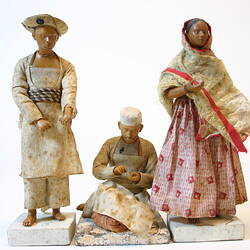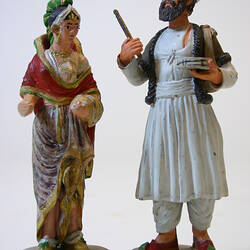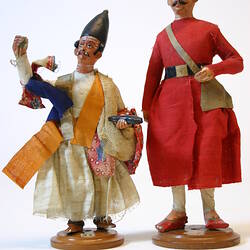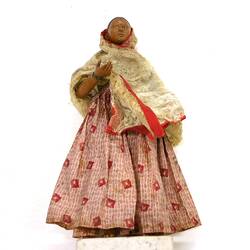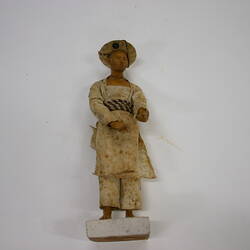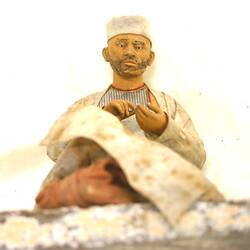The province of Bengal has a long history of clay modelling, with Krishnanagar (a village about 50 miles north of Calcutta) and Kumartuli (a suburb in Calcutta) being the two areas most renowned for their clay modelling (Bean 1990, pp. 30-32).
Clay modelling has been practised in Krishnanagar in West Bengal for over 250 years. Krishnanagar clay models are characterised by their delicacy, attention to detail and animated appearance. They are distinguished from other Indian clay figures by their lifelike appearance and the use of real cloth and hair (Mukharji, 1888, p.59).
Potteries were established in Ghuri, a suburb of Krishnanagar, by Krishnachandra the Maharaja of Krishnanagar in 1728 (Ghose, 2007, pp. 44-45). The location of Ghuri was chosen for settlement because of its location near the river Jalangi, and its proximity to the Maharaja's palace. Originally, potters were brought to Krishnanagar to create religious idols; the earliest known Krishnanagar figure modeller was Mohan Pal 1745-?. Since Mohan Pal, his family has continued modelling clay figures for both religious festivals and the tourist market; the art-form has been passed down through generations and is still practised in Krishnanagar by members of the Pal family today (Bose, 2007).
Kumartuli figure modellers trace their descent back to the idol makers of Krishnanagar; they originally settled in Gobindapore, a village on the banks of the river Bhagirathi, until the East India Company built Fort William. The potters then migrated upriver to Sutanooti and named their settlement Kumartuli (from Kumar, meaning potter, and Tuli, meaning locality). The Kumartuli modellers are famous for their production of religious idols, specifically those for Durga Puja. Today they produce idols for a variety of Hindu ceremonies that are not only used for worship throughout India but are shipped all over the world (Chowdhury 2006). The religious models produced by the modellers of Kumartuli are often quite large and are produced by applying clay over a bamboo and straw armature, which is then sun-dried, painted and clothed (Bean, 1990, pp. 30-32). Kumartuli housed offices for several Krishnanagar modellers, which may account for the attribution of models by Gopal Chandra Pal in the Melbourne International Exhibition Catalogue of 1880 to Calcutta and not Krishnanagar.
References:
Bean, Susan (1990). 'Image Makers of Bengal', Ceramics Monthly, 38(5), pp. 30-32.
Bose, Bhupen (2007). 'Famous Clay Dolls Of Krishnagar' Kashmir Times Sunday Magazine, July 29.
Chowdhury, Amlan Home (2006). 'Kumartuli, Potters Town', Little India, September 14.
Chose, Benoy (1981). Traditional Arts and Crafts of West Bengal: a sociological survey, Calcutta, Papyrus.
Mukharji, T. N. (1888). Art Manufactures of India: specially compiled for the Glasgow International Exhibition, 1888, Calcutta, Superintendent of Government Printing.
More Information
-
Keywords
-
Authors
-
Article types

